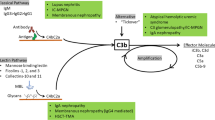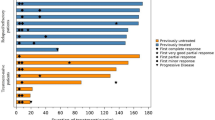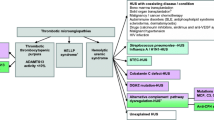Abstract
Interleukin-2 (IL-2) and its receptor (IL-2R) play a central role in T lymphocyte activation and immune response after transplantation. Research on the biology of IL-2R allowed the identification of key signal transduction pathways involved in the generation of proliferative and antiapoptotic signals in T cells. The α-chain of the IL-2R is a specific peptide against which monoclonal antibodies have been raised, with the aim of blunting the immune response by means of inhibiting proliferation and inducing apoptosis in primed lymphocytes. Indeed, basiliximab, one of such antibodies, has proved to be effective in reducing the episodes of acute rejection after kidney and pancreas transplantation.
The use of basiliximab was associated with a significant reduction in the incidence of any treated rejection episodes after kidney transplantation in the two major randomised studies (placebo 52.2% vs basiliximab 34.2% at 6 months, European study; placebo 54.9% vs basiliximab 37.6% at 1 year, US trial). Basiliximab and equine antithymocyte globulin (ATG) administration resulted in a similar rate of biopsy-proven acute rejection at 6 months (19% for both) and at 12 months (19% and 20%, respectively). The use of basiliximab appears not to be associated with an increased incidence of adverse events as compared with placebo in immunosuppressive regimens, including calcineurin inhibitors, mycophenolate mofetil or azathioprine and corticosteroids, and its safety profile is superior to ATG. Moreover, a similar occurrence of infections is noted in selected studies (65.5% after basiliximab vs 65.7% of controls), including cytomegalovirus infection (17.3% vs 14.5%), and cytokine-release syndrome is not observed. Finally, economic analysis demonstrated lower costs of overall treatment in patients treated with basiliximab.
Therefore, the use of basiliximab entails a very low risk, allows safe reduction of corticosteroid dosage and reduces the short- and mid-term rejection rates. However, the improvement in the long-term survival of kidney grafts in patients treated according to modern immunosuppressive protocols is still to be demonstrated. These conclusions are based on a systematic review of the scientific literature, indexed on Medline database, concerning the mechanism of action, therapeutic activity, safety and pharmacoeconomic evaluation of basiliximab in renal transplantation.




Similar content being viewed by others
Notes
The use of tradenames is for product identification purposes only and does not imply endorsement.
References
Murray JE, Merill JP, Harrison JH. Kidney transplantation between seven pairs of identical twins. Ann Surg 1958; 148: 343–57
Danesi R, Mosca M, Boggi U, et al. Genetics of drug response to immunosuppressive treatment and prospects for personalized therapy. Mol Med Today 2000 Dec; 6(12): 1535–43
Kahan BD, Ponticelli C, editors. Principles and practice of renal transplantation. London: Martin Dunitz Ltd, 2000
Birkeland SA. Uremia as a state of immune deficiency. Scand J Immunol 1976; 5(1-2): 107–15
Descamps-Latscha B, Herbelin A, Nguyen AT, et al. Immune system dysregulation in uremia. Semin Nephrol 1994 May; 14(3): 253–60
Cecka JM. The UNOS scientific renal transplant registry. In: Terasaki PI, Cecka JM, editors. Clinical transplants 1998. Los Angeles (CA): UCLA Tissue Typing Laboratory, 1999: 421–36
Ehrich JH, Loirat C, Brunner FP, et al. Report on management of renal failure in children in Europe, XXII, 1991. Nephrol Dial Transplant 1992; 7Suppl. 2: 36–48
Feucht HE, Opelz G, The humoral immune response towards HLA class II determinants in renal transplantation. Kidney Int 1996 Nov; 50(5): 1464–75
Carmellini M, Vistoli F, Boggi U, et al. Delayed graft function incidence as predictive variable of survival of kidney grafts retrieved from elderly donors. Transplant Proc 2000 Feb; 32(1): 128–30
Nashan B, Moore R, Amolt P, et al. Randomised trial of basiliximab versus placebo for control of acute cellular rejection in renal allograft recipients. Lancet 1997 Oct 25; 350(9086): 1193–8
Kahan BD, Rajagopalan PR, Hall M, et al. Reduction of the occurrence of acute cellular rejection among renal allograft recipients treated with basiliximab, a chimeric anti-interleukin-2-receptor monoclonal antibody. Transplantation 1999 Jan; 67(2): 276–84
Ponticelli C, Yussim A, Cambi V, et al. Simulect Phase IV Study Group: a randomized, double-blind trial of basiliximab immunoprophylaxis plus triple therapy in kidney transplant recipients. Transplantation 2001 Oct 15; 72(7): 1261–7
Folkmane I, Bicans J, Amerika D, et al. Low rate of acute rejection and cytomegalovirus infection in kidney transplant recipients with basiliximab. Transplant Proc 2001 Nov-Dec; 33(7-8): 3209–10
Boggi U, Vistoli F, Del Chiaro M, et al. CSA/MMF/steroids versus CSA/AZA/steroids with and without basiliximab in cadaveric kidney transplantation. Transplant Proc 2001 Nov-Dec; 33(7-8): 3199–200
Sollinger H, Kaplan B, Pecovitz MD, et al. Basiliximab versus antithymocyte globulin for prevention of acute renal allograft rejection. Transplantation 2001 Dec; 72(12): 1915–9
Lebranchu Y, Bridoux F, Buchler M, et al. Immunoprophylaxis with basiliximab compared with antithymocyte globulin in renal transplant patients receiving MMF-containing triple therapy. Am J Transplant 2002 Jan; 2(1): 48–56
Thistlethwaite JR, Nashan B, Hall M, et al. Reduced acute rejection and superior 1-year renal allograft survival with basiliximab in patients with diabetes mellitus. Transplantation 2000 Sep 15; 70(5): 784–90
Boggi U, Vistoli F, Coppelli A, et al. Use of basiliximab in conjunction with either Neoral/MMF/steroids or Prograf/MMF/steroids in simultaneous pancreas-kidney transplantation. Transplant Proc 2001 Nov-Dec; 33(7-8): 3201–2
Kumar MSA, Kode RK, Pankewycz, et al. Simulect, Neoral, Cellcept and prednisone in kidney recipients with delayed graft function: a prospective controlled study. Transplant Proc 2001; 33(7-8): 3762–3
Vester U, Kranz B, Testa G, et al. Efficacy and tolerability of interleukin-2 receptor blockade with basiliximab in pediatric renal transplant recipients. Pediatr Transplant 2001 Aug; 5(4): 297–301
Pape L, Strehlau J, Henne T, et al. Single centre experience with basiliximab in paediatric renal transplantation. Nephrol Dial Transplant 2002 Feb; 17(2): 276–80
Clark G, Walsh G, Deshpande P, et al. Improved efficacy of basiliximab over antilymphocyte globulin induction therapy in paediatric renal transplantation. Nephrol Dial Transplant 2002 Jul; 17(7): 1304–9
Morris JC, Waldmann TA. Advances in interleukin 2 receptor targeted treatment. Ann Rheum Dis 2000 Nov; 59Suppl. 1: i109–14
Gaffen SL. Signaling domains of the interleukin 2 receptor. Cytokine 2001 Apr 21; 14(2): 63–77
Ellery JM, Nicholls PJ. Possible mechanism for the alpha subunit of the interleukin-2 receptor (CD25) to influence interleukin-2 receptor signal transduction. Immunol Cell Biol 2002 Aug; 80(4): 351–7
Goebel J, Stevens E, Forrest K, et al. Daclizumab (Zenapax) inhibits early interleukin-2 receptor signal transduction events. Transpl Immunol 2000 Nov; 8(3): 153–9
Baan CC, van Riemsdijk-Overbeeke IC, Boelaars-van Haperen MJ, et al. Inhibition of the IL-15 pathway in anti-CD25 mAb treated renal allograft recipients. Transpl Immunol 2002 Jun; 10(1): 81–7
Kovarik JM, Kahan BD, Rajagopalan PR, et al. On behalf of the US Simulect Renal Transplant Study Group. Population pharmacokinetics and exposure-response relationships for basiliximab in kidney transplantation. The US Simulect Renal Transplant Study Group. Transplantation 1999 Nov 15; 68(9): 1288–94
Kovarik J, Wolf P, Cisterne JM, et al. Disposition of basiliximab, an interleukin-2 receptor monoclonal antibody, in recipients of mismatched cadaver renal allografts. Transplantation 1997 Dec 27; 64(12): 1701–5
Kovarik JM, Moore R, Wolf P, et al. Screening for basiliximab exposure-response relationships in renal allotransplantation. Clin Transplant 1999 Feb; 13(1 Pt 1): 32–8
Kovarik JM, Pescovitz MD, Sollinger HW, et al. On behalf of the Simulect Phase IV Study Group. Differential influence of azathioprine and mycophenolate mofetil on the disposition of basiliximab in renal transplant patients. Clin Transplant 2001 Apr; 15(2): 123–30
Kovarik JM, Offner G, Broyer M, et al. A rational dosing algorithm for basiliximab (Simulect) in pediatric renal transplantation based on pharmacokinetic-dynamic evaluations. Transplantation 2002 Oct; 74(7): 966–71
Mentre F, Kovarik J, Gerbeau C. Constructing a prediction interval for time to reach a threshold concentration based on a population pharmacokinetic analysis: an application to basiliximab in renal transplantation. J Pharmacokinet Biopharm 1999 Apr; 27(2): 213–30
Kovarik JM, Nashan B, Neuhaus P, et al. A population pharmacokinetic screen to identify demographic-clinical covariates of basiliximab in liver transplantation. Clin Pharmacol Ther 2001 Apr; 69(4): 201–9
Strehlau J, Pape L, Offner G, et al. Interleukin-2 receptor antibody-induced alterations of ciclosporin dose requirements in paediatric transplant recipients. Lancet 2000 Oct 14; 356(9238): 1327–8
Kovarik JM, Korn A, Chodoff L. Within-patient controlled assessment of the influence of basiliximab on cyclosporine in pediatric de novo renal transplant recipients. Transplant Proc 2001 Nov-Dec; 33(7-8): 3172–3
Sifontis N, Benedetti E, Vasquez E. Clinically significant drug interaction between basiliximab and tacrolimus in renal transplant recipients. Transplant Proc 2002 Aug; 34(5): 1730–2
Lo A, Stratta RJ, Alloway RR, et al. Initial clinical experience with interleukin-2 receptor antagonist induction in combination with tacrolimus, mycophenolate mofetil and steroids in simultaneous kidney-pancreas transplantation. Transpl Int. 2001 Dec; 14(6): 396–404
Swiatecka-Urban A, Garcia C, Feuerstein D, et al. Basiliximab induction improves the outcome of renal transplants in children and adolescents. Pediatr Nephrol 2001 Sep; 16(9): 693–6
Vanrenterghem YF. Tailoring immunosuppressive therapy for renal transplant recipients. Pediatr Transplant 2001 Dec; 5(6): 467–72
Onrust SV, Wiseman LR. Basiliximab. Drugs 1999 Feb; 57(2): 207–13
Moser MA. Options for induction immunosuppression in liver transplant recipients. Drugs 2002; 62(7): 995–1011
Cantarovich M, Metrakos P, Giannetti N, et al. Anti-CD25 monoclonal antibody coverage allows for calcineurin inhibitor ‘holiday’ in solid organ transplant patients with acute renal dysfunction. Transplantation 2002 Apr 15; 73(7): 1169–72
Barros VR, Rocha V, Garcia VD, et al. Anaphylactic shock after retreatment with basiliximab. Transplant Proc 2003 Feb; 35(1): 579
Cosimi AB. Clinical development of orthoclone OKT3. Transplant Proc 1987 Apr; 19(2 Suppl. 1): 7–16
Ortho Multicenter Transplant Study Group. A randomized clinical trial of OKT3 monoclonal antibody for acute rejection of cadaveric renal transplants. N Engl J Med 1985 Aug 8; 313 (6): 337–42
Swinnen LJ, Costanzo-Nordin MR, Fisher SG, et al. Increased incidence of lymphoproliferative disorders after immunosuppression with the monoclonal antibody OKT3 in cardiac transplant recipients. N Engl J Med 1990 Dec 20; 323(25): 1723–8
Gaber AO, First MR, Tesi RJ, et al. Results of double-blind, randomized, multicenter, phase III clinical trial of thymoglobulin versus ATGAM in the treatment of acute graft rejection episodes after renal transplantation. Transplantation 1998 Jul 15; 66(1): 29–37
Vincenti F, Kirkman R, Light S, et al. Interleukin-2 receptor blockade with daclizumab to prevent acute rejection in renal transplantation. N Engl J Med 1998 Jan 15; 338(3): 161–5
Hale G, Waldmann H. Control of graft-versus-host disease and graft rejection by t-cell depletion of donor and recipient with Campath-1 antibodies: results of matched sibling transplants for malignant diseases. Bone Marrow Transplant 1994 May; 13(5): 597–611
Galliland LK, Walsh LA, Frewin MR, et al. Elimination of immunogenicity of therapeutic antibodies. J Immunol 1999 Mar 15; 162(6): 3663–71
Rebello PR, Hale G, Friend PJ, et al. Anti-globulin responses to rat and humanized campath-1 monoclonal antibody used to treat transplant rejection. Transplantation 1999 Nov 15; 68(9): 1417–20
Calne R, Friend P, Moffatt S, et al. Prope tolerance, perioperative Campath 1 H, and low-dose cyclosporine monotherapy in renal allograft recipients. Lancet 1998 Jun 6; 351(9117): 1701–2
Calne R, Moffatt SD, Friend PJ, et al. Campath 1 H allows lowdose cyclosporine monotherapy in 31 cadaveric renal allograft recipients. Transplantation 1999 Nov 27; 68(10): 1613–6
Suzuki T, Enosawa S, Kakefuda T, et al. A novel immunosuppressant, FTY720 with a unique mechanism of action induces long-term graft acceptance in rat and dog allotransplantation. Transplantation 1996 Jan 27; 61(2): 200–5
Wang ME, Tejpal N, Qu X, et al. Immunosuppressive effects of FTY720 alone or in combination with cyclosporine or sirolimus. Transplantation 1998 Apr 15; 65(7): 899–905
Troncoso P, Stepkowski SM, Wang ME, et al. Prophylaxis of acute renal allograft rejection using FTY720 in combination with subtherapeutic doses of cyclosporine. Transplantation 1999 Jan 15; 67(1): 145–51
Brunkhorst R, Neumayer H-H, Hiss M, et al. Human safety and pharmacology of FTY720 [abstract]. 18th Annual Meeting of the American Society of Transplantation; 1999 May 15-19; Chicago (IL): 585
Keown PA, Balshaw R, Krueger H, et al. Economic analysis of basiliximab in renal transplantation. Transplantation 2001 Jun 15; 71(11): 1573–9
Lorber MI, Fastenau J, Wilson D, et al. A prospective economic evaluation of basiliximab (Simulect) therapy following renal transplantation. Clin Transplant 2000 Oct; 14(5): 479–85
Polsky D, Weinfurt KP, Kaplan B, et al. An economic and quality-of-life assessment of basiliximab vs antithymocyte globulin immunoprophylaxis in renal transplantation. Nephrol Dial Transplant 2001 May; 16(5): 1028–33
Aalamian Z. Reducing adverse effects of immunosuppressive agents in kidney transplant recipients. Prog Transplant 2001 Dec; 11(4): 271–82
Acknowledgements
The service rendered to the scientific community by the Internet-accessible Medline database — URL: http://www.ncbi.nlm.nih.gov/PubMed/) is gratefully acknowledged. The authors have no conflict of interests that may be relevant to the contents of the manuscript. The authors have provided no information on sources of funding.
Author information
Authors and Affiliations
Corresponding author
Rights and permissions
About this article
Cite this article
Boggi, U., Danesi, R., Vistoli, F. et al. A Benefit-Risk Assessment of Basiliximab in Renal Transplantation. Drug-Safety 27, 91–106 (2004). https://doi.org/10.2165/00002018-200427020-00002
Published:
Issue Date:
DOI: https://doi.org/10.2165/00002018-200427020-00002




